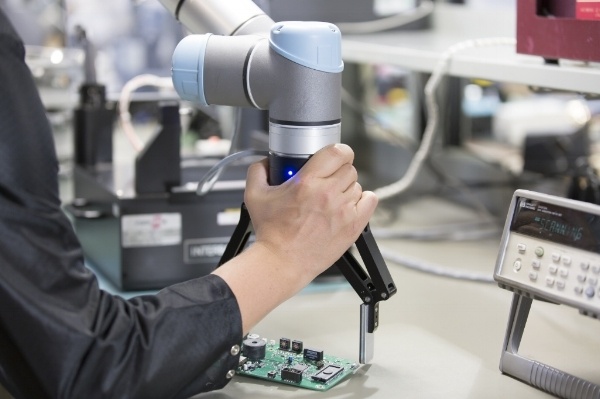Five Reasons Business Leaders Mistrust Robots

Posted on Apr 26, 2017 7:00 AM. 5 min read time
Business leaders can be understandably hesitant about the promises of new technology. Where does this doubt come from and how can we address it?
Just over a year ago, I wrote an article here on the Robotiq blog about The Real Reason Workers Distrust New Technology. For me, it was quite an enlightening post to write. I hadn't realized how long automation has been causing workers to fear for their jobs (as far back as the 18th century, it turned out).
But, fear of job loss is only one aspect of the uncertainty that comes with automation and front-line workers are not the only people to have concerns. Managers and business owners are often hesitant about the promises of new technology, for very understandable reasons.
Whether you are worried about Bill Gates' proposed "robot tax" or simply think that robots will take too much time to implement, this article discusses five reasons that business leaders hesitate over robotics.

1. Lack of Knowledge
 Robotics and automation are still relatively new, particularly for smaller businesses. As a key decision maker, it's natural to be wary of technology with which you have little previous experience. You may wonder if automation really lives up to its promises, or if it is all hype.
Robotics and automation are still relatively new, particularly for smaller businesses. As a key decision maker, it's natural to be wary of technology with which you have little previous experience. You may wonder if automation really lives up to its promises, or if it is all hype.
Thankfully, there is a lot of very clear, useful information out there. It is now easier than ever to get yourself up to speed with the pros and cons of robotic automation.
How to Overcome a Lack of Robotics Knowledge
The first step to overcoming a lack of knowledge is to start reading into the capabilities of robotic systems. You have already started to do this by reading this article. Make sure to read more of the articles here on the Robotiq blog, which should give you a good grasp of the basics. Perhaps even download one of our eBooks which go into more detail on specific topics.
Of course, you do not have to become a robotics expert yourself. Get other members of your team on board and make full use of their knowledge to help you come to an informed decision about how you could use automation in your business.
2. Too Costly
 Cost is a deciding factor in any business decision and the cost of a robot has traditionally been high. However, collaborative robots are generally much cheaper than industrial robots, meaning that the cost factor is less of an issue — but it is still an issue.
Cost is a deciding factor in any business decision and the cost of a robot has traditionally been high. However, collaborative robots are generally much cheaper than industrial robots, meaning that the cost factor is less of an issue — but it is still an issue.
As with all technology purchases, the question should not be "How much does the technology cost?" but rather "What is its Return on Investment?" With collaborative robots, the payback time is often low but the exact numbers depend on your unique business situation.
How to Calculate the True Cost of Robotics
We have covered the cost of collaborative robots here on the blog before. To learn how you can plan the costs to your business, a good place to start is our recent post: How to Plan a Robotics Budget for 2017.
One particularly useful resource is our Robot ROI Calculator, along with its companion article What is an Average Price for a Collaborative Robot?
3. Too Much Work
You may be concerned that robotics will be too much work to implement in your business. In truth, it can take a lot of work to integrate any new technology into a business. Robots are no different. Collaborative robots are simple to operate, but they are not strictly plug-and-play (though they are pretty close to it).
Like cost, the key to assessing the time investment of robotic technology is to consider how much time the robot saves you in the future.
How to Assess Implementation Time
You can get a rough idea of how long a robot takes to set up and program by watching the process in action. Then, consider how long the same task may take in your business. Our video library is a great place to start. We have many videos which clearly show how to carry out robot installation and program specific applications.
4. Technology Means Training
 Introducing new technology invariably means training staff to use it. We all know that this can introduce quite a large overhead, which may make you think twice about introducing robotics. You may wonder if you have enough resources to implement a whole training program and whether it will even be worth it. Never fear, collaborative robot training is much simpler than you might think.
Introducing new technology invariably means training staff to use it. We all know that this can introduce quite a large overhead, which may make you think twice about introducing robotics. You may wonder if you have enough resources to implement a whole training program and whether it will even be worth it. Never fear, collaborative robot training is much simpler than you might think.
How to Get a Kick Start With Robotics Training
We have covered robotics training a lot recently here on the Robotiq blog. We just released our ten part eBook series about how to train your workforce in robotics. Find out more in the blog post How Much Robotics Expertise Does a Business Need?.
5. Politics and Publicity
There has been a lot of activity in the media recently regarding the politics of robotics, which may make some people question the viability of robots.
Most recently, Bill Gates proposed a "robot tax" which he says will reduce the effects of job displacement by automation. However, although it received notable media attention, he is not the first person to suggest an automation tax and the discussion is still very much in its infancy. The question of how to handle robotics politically will take some time to reach any conclusions.
You may also be concerned with the worrisome publicity that robotics has been receiving lately, most of which has been about job displacement by automation. As I discovered in my previous post, this is by no means a new concern. In most cases, it is pure media hype.
How to Prepare for Robot Politics
If you are concerned about robot politics, a good place to find out more is our previous article Three Ways Robot Politics Will Affect Businesses. It discusses some of the proposed legislation around automation and describes some of the different sides of the debate.
I think it's safe to say that we are quite far away from any definite measures being placed on businesses who use robots. For now, there is nothing to worry about.
The main legal issue you should concern yourself with is the safety aspect of robotics. You can find out more in our eBooks Collaborative Robot Risk Assessment, An Introduction and ISO/TS 15066 Explained.
I have listed only five of the various reasons you might hesitate about robotics. If you have any other concerns, please tell us about them in the comments below or join the discussion on LinkedIn, Twitter, Facebook or the DoF professional robotics community.



Leave a comment